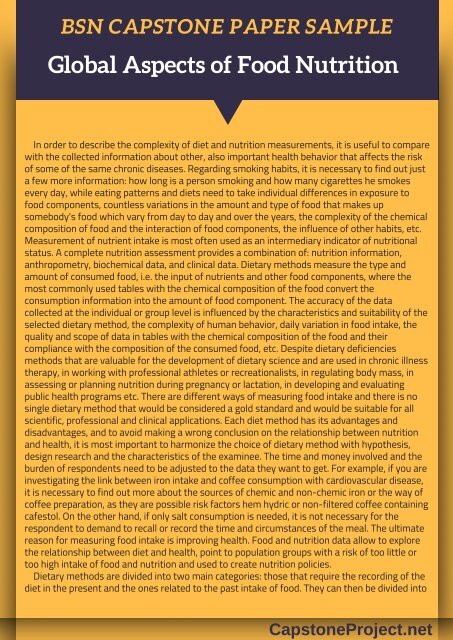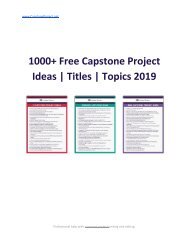bsn-capstone-project-sample
Get the best BSN capstone project sample here: https://www.capstoneproject.net/bsn-capstone-project-ideas/
Get the best BSN capstone project sample here: https://www.capstoneproject.net/bsn-capstone-project-ideas/
You also want an ePaper? Increase the reach of your titles
YUMPU automatically turns print PDFs into web optimized ePapers that Google loves.
CapstoneProject.net<br />
BSN CAPSTONE PAPER SAMPLE<br />
Global Aspects of Food Nutrition<br />
In order to describe the complexity of diet and nutrition measurements, it is useful to compare<br />
with the collected information about other, also important health behavior that affects the risk<br />
of some of the same chronic diseases. Regarding smoking habits, it is necessary to find out just<br />
a few more information: how long is a person smoking and how many cigarettes he smokes<br />
every day, while eating patterns and diets need to take individual differences in exposure to<br />
food components, countless variations in the amount and type of food that makes up<br />
somebody's food which vary from day to day and over the years, the complexity of the chemical<br />
composition of food and the interaction of food components, the influence of other habits, etc.<br />
Measurement of nutrient intake is most often used as an intermediary indicator of nutritional<br />
status. A complete nutrition assessment provides a combination of: nutrition information,<br />
anthropometry, biochemical data, and clinical data. Dietary methods measure the type and<br />
amount of consumed food, i.e. the input of nutrients and other food components, where the<br />
most commonly used tables with the chemical composition of the food convert the<br />
consumption information into the amount of food component. The accuracy of the data<br />
collected at the individual or group level is influenced by the characteristics and suitability of the<br />
selected dietary method, the complexity of human behavior, daily variation in food intake, the<br />
quality and scope of data in tables with the chemical composition of the food and their<br />
compliance with the composition of the consumed food, etc. Despite dietary deficiencies<br />
methods that are valuable for the development of dietary science and are used in chronic illness<br />
therapy, in working with professional athletes or recreationalists, in regulating body mass, in<br />
assessing or planning nutrition during pregnancy or lactation, in developing and evaluating<br />
public health programs etc. There are different ways of measuring food intake and there is no<br />
single dietary method that would be considered a gold standard and would be suitable for all<br />
scientific, professional and clinical applications. Each diet method has its advantages and<br />
disadvantages, and to avoid making a wrong conclusion on the relationship between nutrition<br />
and health, it is most important to harmonize the choice of dietary method with hypothesis,<br />
design research and the characteristics of the examinee. The time and money involved and the<br />
burden of respondents need to be adjusted to the data they want to get. For example, if you are<br />
investigating the link between iron intake and coffee consumption with cardiovascular disease,<br />
it is necessary to find out more about the sources of chemic and non-chemic iron or the way of<br />
coffee preparation, as they are possible risk factors hem hydric or non-filtered coffee containing<br />
cafestol. On the other hand, if only salt consumption is needed, it is not necessary for the<br />
respondent to demand to recall or record the time and circumstances of the meal. The ultimate<br />
reason for measuring food intake is improving health. Food and nutrition data allow to explore<br />
the relationship between diet and health, point to population groups with a risk of too little or<br />
too high intake of food and nutrition and used to create nutrition policies.<br />
Dietary methods are divided into two main categories: those that require the recording of the<br />
diet in the present and the ones related to the past intake of food. They can then be divided into
CapstoneProject.net<br />
Global Aspects of Food Nutrition<br />
those who look at the daily intake (diet diary and 24-hour remembrance) or the usual or<br />
average diary (diet history and consumption frequency questionnaire), i.e. those based on meals<br />
(diet diary and 24-hour remembrance) or in the food list (consumption frequency questionnaire).<br />
It is further possible to divide the obtained data that may relate to absolute or relative input. It<br />
has recently been considered that it is impossible to measure one's diet and that the nutrition<br />
within a culture is too homogenous to establish a connection with health. Today, the concept of<br />
diet and health is unquestioned, largely due to the development of dietary methods. It is<br />
important to take into account that dietary methods improperly measure food intake and<br />
critically interpret the results of dietary and health related research, but dietary methods<br />
currently used do not have adequate substitution and additional research is needed to define<br />
new ways of measuring nutrition or new statistical methods that would the combination of the<br />
results of several different diet methods gave a more accurate estimate of the usual intake.<br />
More and more, biomarkers have been increasingly used, but they are not without mistakes and<br />
are not a substitute but a supplement to dietary methods: biomarkers help interpret data on<br />
dieting, and dietary methods show the influence of biomarker intake.<br />
The food tables and collection databases are information about the composition of food and<br />
beverages. They represent an important source of information on the nutrient content and<br />
other nutrient information, and are therefore essential for working in nutrition, public health,<br />
nutrition policy, epidemiological research, new product development and labeling of nutritional<br />
products. Many European countries have their own national tables which mainly comprise<br />
domestic producers and products that residents often consume. It is known that, for example,<br />
breed, age, and animal breeding mode also affect the total amount of fat, as well as fatty acid<br />
composition and cholesterol content. Depending on varieties, seasonal conditions, growth and<br />
storage conditions, the composition / ratio of nutrients in foodstuffs of plant origin may be<br />
different. The content of a single macronutrient in varieties of the same species (species) may<br />
differ by up to ten times, and even more pronounced, there may be differences in micronutrient<br />
composition. The great supply of food and food products in modern times, which is also global,<br />
has prompted the creation of a regional and international network of workgroups for the<br />
development and replenishment of food information databases. Exchange data between<br />
network members reduces the cost of updating the tables while simultaneously quickly tracking<br />
the needs of a table user who needs the latest and detailed information about the food<br />
composition in their work. Food tablets are usually written in the form of books, and for many<br />
years they have been their only form. At the end of the 19th century, the first tablets in the<br />
tablets were published in Germany, which we use today. The first food tables were based solely<br />
on analytical data. Along with the growing array and variety of foods of these nutrients and<br />
other nutrients that could be identified, analysis of all components became uneconomic for<br />
table makers. Some of the available data, such as vitamin content, are taken from scientific<br />
publications. Modern nutrition tables are based primarily on data obtained from chemical<br />
analysis of food <strong>sample</strong>s, while other data is derived from baseline data calculations and
CapstoneProject.net<br />
Global Aspects of Food Nutrition<br />
"borrowing" data from other sources such as other country databases, scientific publications,<br />
and producer data. The tables include average values and ranges, that is, the minimum and<br />
maximum value of the food component content. Computer Era has favored databases, which in<br />
electronic form can capture a large amount of data and at the same time allow easy access to<br />
data and manage them. The database is the basis of information not only about the<br />
composition of food and beverages but also about the origin of these foods, the method of<br />
sampling, analytical methods, sources of other data, material for packaging etc. The electronic<br />
databases allow for a quicker view and editing of content as well as faster exchange of<br />
information between countries, but must be mutually comparable and compatible. In order to<br />
achieve this, the construction of the database is based on international recommendations and<br />
European standards for food preparation and the development of databases and tables. Instead<br />
of verbal descriptions of food, which are usually too long, and their meanings in translation into<br />
another language are easily lost or changed, labeling is fed into databases using indexing. Most<br />
European food indices are used by the LanguaLTM system, which provides a systematic<br />
description of the food and its classification.<br />
References<br />
Rogers, P. J. (2001). A Healthy Body, a Healthy Mind: Long-term Impact of Diet on Mood and<br />
Cognitive Function. Proc Nutr Soc, 60, 135–143.<br />
Setchell, K. D. R., & Cassidy, A. (1999). Dietary Isoflavones: Biological Effects and Relevance<br />
to Human Health. J Nutr, 129, 7585–7675.<br />
Macphail, P. (1998). Iron, in: Mann, J., Truswell, A. S. (Eds.). Essentials of Human Nutrition.<br />
New York: Oxford University Press, 137–149.




